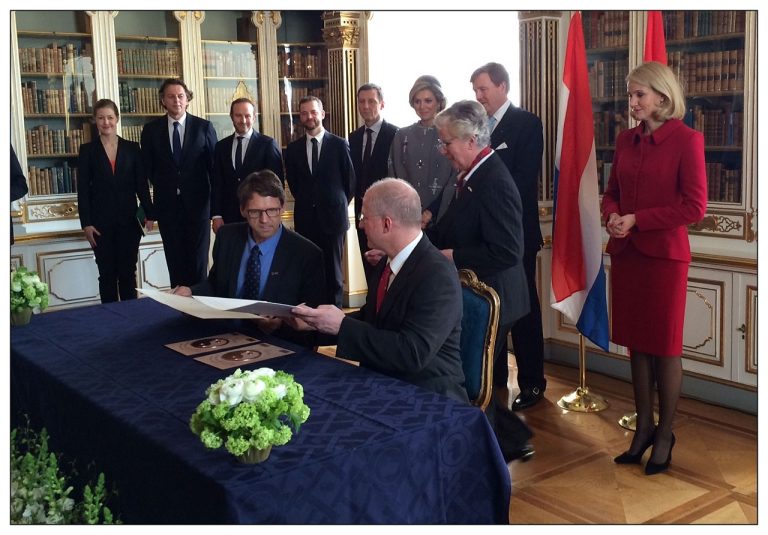Leo Kouwenhoven (Qutech, Delft) and Charles Marcus (QDev, Copenhagen) signed an agreement for a joint development of quantum computing in Copenhagen yesterday. The Dutch royal couple and the Danish prime minister underlined the importance with their presence.
The Memorandum of Understanding states that Qutech at the Kavli Institute for Nanoscience (TU Delft) and QDev at the Niels Bohr Institute (University of Copenhagen) will work on a joint plan based on so-called topological particles that exist in certain materials.
Majoranas, discovered by Professor Kouwenhoven in 2012, are the best known topological particles. By electrically controlling these particles, they can be woven around each other, resulting in interactions that produce quantum information. Among the candidates for quantumbits, Majoranas are the most stable since they’re immune to most sources of disturbance.
The research programme will develop advanced materials for nano-electronics made from semiconducting nanowires – the habitat for Majoranas. The research institutes will share research facilities and exchange researchers and students.
“We have been working together with them quite a lot already”, said Professor Kouwenhoven (Faculty of Applied Sciences). “We now have the ambition to be the spindle in an international network for the development of the quantum computer. The next years will determine where in the world the pith of the matter will be located for the development of the first quantum computer. Together we can assure Europe’s pivotal role in this field.”
Professor Charles Marcus, who joined the Niels Bohr Institute from Harvard in 2012, said, “With the growing complexity of quantum information, combining efforts – as we are doing with this declaration – is hardly a choice anymore. Exchanging ideas, techniques, education and especially personnel makes everything easier, hopefully easy enough to succeed.”


The Office
The Niels Bohr Institute was the appropriate place to start the ceremony. The famous Danish scientist with the same name, who was one of the founding fathers of quantum physics at the beginning of the 20th century, initiated it. In Bohr’s old office, the main players sat around the table. The professors were joined by TU Delft’s president Dirk Jan van den Berg , the Danish minister of higher education & science Sofie Carsten Nielsen and the Dutch minister of foreign affairs Bert Koenders.


Underskrift
In the afternoon the party transferred to Christiansborg, the seat of the Danish Parliament in Copenhagen, for the signing act. Watching the ‘underskrift’ ceremony were the Dutch royal couple, King Willem Alexander and Queen Maxima, and the Danish prime minister, Helle Thorning-Schmidt.
With the festivities behind them, the researchers went back to work on Wednesday with a scientific programme at the Center for Quantum Devices, QDev, at the Niels Bohr Institute.



Comments are closed.